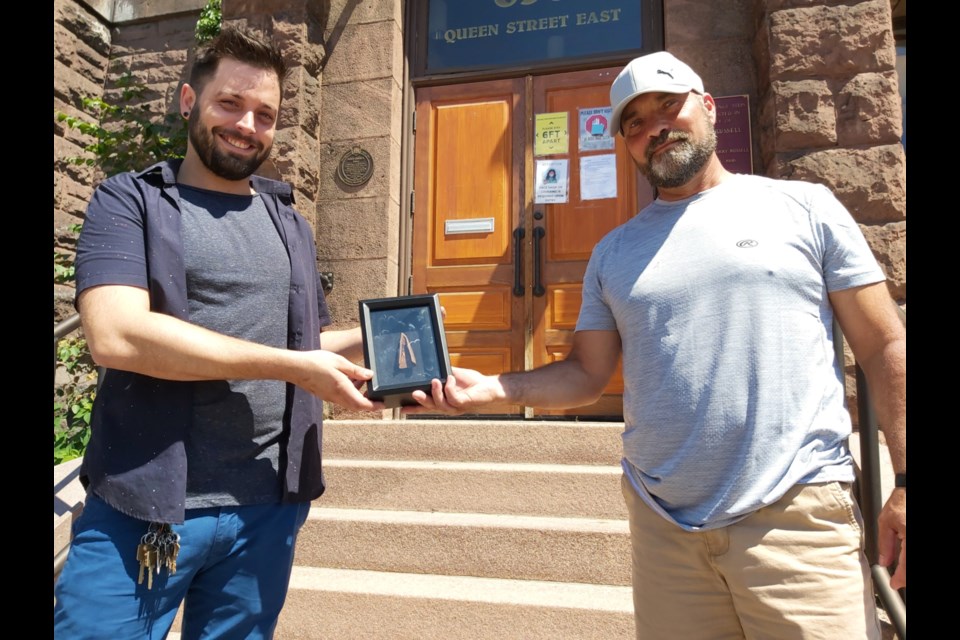For many who enjoy metal detecting as a hobby, discovering a seemingly ordinary object which turns out to be of great historical significance outweighs its monetary value (whether big or small).
Several weeks ago, Sault detectorist Rob Gioia made a unique find along the shores of the St. Marys River.
He found what could be a spear tip from the days of the ‘Old Copper Culture.’
Old Copper Culture is a term used to describe ancient Indigenous North American societies which used copper for tools or weapons.
“It is estimated to be 3,000 to 5,000 years old,” Gioia told SooToday.
“I investigated the piece through personal research as well as receiving input from several contacts familiar with Copper Culture artifacts. The relic was authenticated by a Milwaukee Public Museum anthropologist who dated it accordingly. I reached out to this trusted source since the museum has a large anthropology and research section. They house an impressive collection of Copper Culture artifacts,” Gioia said.
“I believe the historical and cultural significance (of the ancient copper object) compels me to donate this relic to the citizens of Sault Ste. Marie, to our museum, so that it may be enjoyed by all.”
Gioia also recorded the GPS coordinates of the find to share with the archeological community.
The significance of the relic, Gioia said, “cannot be overstated.”
“It is an artifact that predates European contact by several thousand years but is also a testament to the resilience and ingenuity of the early inhabitants of the Great Lakes Region.”
“Holding something that was crafted by someone's hands thousands of years ago is a humbling experience,” Gioia said.
“Most people are oblivious to the fact that ancient Indigenous North American societies used copper to fashion weapons and tools, such as chisels, harpoons, knives, spikes, awls, needles, fish hooks and other objects, as well as jewelry. This relic was specific to early inhabitants of the Great Lakes Region, spanning several thousand years and covering several thousand square miles,” Gioia said.
Gioia said the relic is in “amazing condition,” adding “it seems as though it could have been made yesterday (through being under water and washed in the sand for centuries).”
“It still bears marks of the individual who created it...a very personal connection to an ancient past that is invariably woven into the historical fabric of Sault Ste. Marie itself,” Gioia said.
"The Sault Ste. Marie Museum is pleased to accept this significant donation from Mr. Gioia,” said William Hollingshead, Sault Ste. Marie Museum executive director and chief curator.
“The culture and heritage of Sault Ste. Marie is vast reaching and significant to not only Algoma but also Ontario. Artifacts like this offer us the ability to better learn from and understand this history, and to present it in a more complete way to our community. Often as time passes, we inherently lose certain aspects or insights into the full aspect of any history at a specific point. To bring these items back into the narrative allows us to gain this better understanding and reflection of the past in order to inform both the present and future," Hollingshead said.
“It’s exciting to have a piece like this in the museum and on display for the community and all our visitors. Now that we’re reopening (during the COVID-19 pandemic) I think it’s a great time for people to stop by and check out some of the new stuff we have along with this fantastic artifact which will go on display. It’ll probably go in our Skylight Gallery on the second floor, which is a ‘walk through’ history of Sault Ste. Marie,” Hollingshead said.
Sault Ste. Marie Museum hours are by appointment (due to COVID precautions, approximately 15 visitors at a time), from 10 a.m to 4 p.m., Tuesday through Saturday.
“The most rewarding part of metal detecting is the journey of discovery involved in locating and identifying a piece. At the end of the day the best part of that journey is sharing what you have subsequently learned with others,” Gioia said.
“Responsible metal detecting is not a hobby that steals history and is destructive in the process. Instead, it is all about the hunt for history in order to save it from an earthy grave of obscurity. Above all, history should not be possessed or denied, but should be shared with everyone who collectively holds stake in the past.”
Through donating the relic to the Sault Ste. Marie Museum, Gioia said “I am very happy to have found it the proper home.”
Gioia presented the ancient object in a shadow box to Hollingshead at the museum Friday.
“It’s phenomenal. I can’t keep it to myself,” Gioia told Hollingshead near the museum’s front entrance.
“I wanted to find it a home, and aside from the benefit to the citizens of Sault Ste. Marie, it also bodes well for the hobby of responsible metal detecting.”
